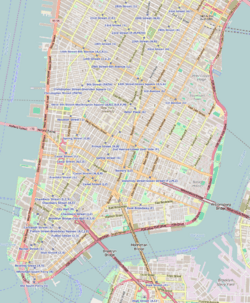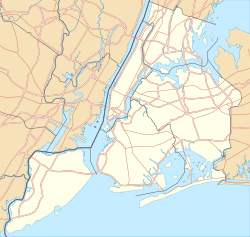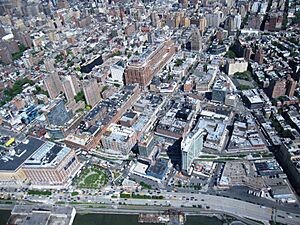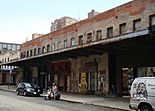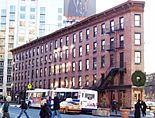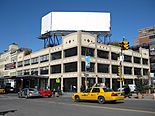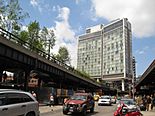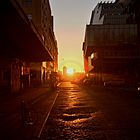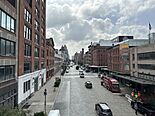Meatpacking District, Manhattan facts for kids
|
Gansevoort Market Historic District
|
|
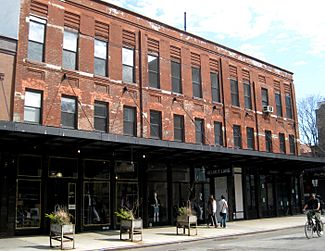
An old meatpacking building converted into a boutique
|
|
| Location | Roughly bounded by West 16th Street to the north; Ninth Avenue, and Hudson Street to the east; Gansevoort Street to the south; and West Street and 11th Avenue to the west Manhattan, New York City |
|---|---|
| Area | 44 acres (18 ha) |
| Architect | various |
| Architectural style | various |
| NRHP reference No. | 07000487 |
Quick facts for kids Significant dates |
|
| Added to NRHP | May 30, 2007 |
The Meatpacking District is a cool neighborhood in Manhattan, New York City. It stretches from West 14th Street south to Gansevoort Street. On the west, it reaches the Hudson River, and on the east, it goes to Hudson Street.
Some signs in the area show that the Meatpacking District's borders are a bit wider. They go north to West 17th Street, east to Eighth Avenue, and south to Horatio Street.
Contents
Discovering the Meatpacking District's History
Ancient Times: Native American Roots
Long ago, a Native American trading spot called "Sapohanikan" was located on the riverbank. This spot is now roughly where Gansevoort Street meets Washington Street. A path from Sapohanikan led inland and later became Gansevoort Street. Interestingly, this street lines up almost perfectly with the sun during the spring and fall equinoxes!
Early Growth: From Forts to Factories
The Meatpacking District began to develop in the mid-1800s. Before that, it was home to Fort Gansevoort. It was also the northern part of Greenwich Village, a popular vacation spot. The streets here are a bit mixed up because the old Greenwich Village roads met New York City's planned grid system.
Around 1840, people started building homes here. These were mostly rowhouses and town houses. Some were later turned into tenements, which are buildings with many small apartments. By the mid-1800s, Fort Gansevoort was replaced by train yards. The area became a mix of homes and heavy industries. This included iron works and factories making terra cotta. Lighter industries like carpentry and lumber yards were also present. During the American Civil War, many distilleries making turpentine and lamp fuel were found here.
After the Civil War: Meat and Markets
After the Civil War, in the 1870s, the neighborhood changed. It was no longer a popular place to live. So, more multi-family buildings were built instead of single homes. Industry also continued to grow. An elevated train line was built through the area in 1869.
In the 1880s, two new markets opened. The Gansevoort Market, an open-air space for selling farm produce, started in 1879. The West Washington Market, with brick buildings for meat, poultry, and dairy, moved here in 1884. By 1900, there were 250 slaughterhouses and packing plants in the area! By the 1920s, the neighborhood became mostly about meatpacking. Other businesses, like car repair shops and printing companies, were still there too. In 1934, the High Line elevated freight train line was completed, running through the district.
Changes Over Time: Decline and Comeback
The area started to decline around the 1960s. This was partly because of new ways to ship goods and the rise of supermarkets. Frozen foods and refrigerated trucks also changed how meat and produce were distributed. Even so, meatpacking remained the main activity through the 1970s.
In the late 1990s, the Meatpacking District began to transform. Fancy boutiques and trendy restaurants started opening. Famous designers like Diane von Fürstenberg and Christian Louboutin opened stores. Popular restaurants and nightclubs also appeared. In 2004, New York magazine called it "New York’s most fashionable neighborhood."
A big change happened in 2009 when the first part of the High Line park opened. This park was built on an old elevated train track. It became a popular green space, similar to a park in Paris. In 2015, the Whitney Museum of American Art opened its new building here. These changes turned the Meatpacking District from a gritty industrial area into a lively place for shopping, dining, and living.
Protecting the Past: Historic Preservation Efforts
By 2003, only 35 of the 250 meatpacking plants from the 1900s were still left.
In September 2003, the New York City Landmarks Preservation Commission (LPC) created the Gansevoort Market Historic District. This was after groups like the Greenwich Village Society for Historic Preservation worked hard to protect the area. In 2007, the entire Meatpacking District was added to the New York State and National Registers of Historic Places. This means it's recognized as an important historic place.
Since then, people have continued to work to protect the area's unique feel. For example, in 2004, a plan for a very tall building was stopped. In 2009, developers wanted to build a large glass office tower. Groups like GVSHP opposed it because it would change the neighborhood's low-rise look. While some changes have happened, efforts continue to keep the district special. One traditional feature that remains are streets paved with Belgian blocks, which look like cobblestones.
Gallery
-
Before gentrification, many meatpacking buildings had become derelict
-
The Standard Hotel above the High Line
-
Gansevoort Street is almost perfectly aligned to the Spring equinox
-
View of W 14th St from The High Line
See also
 In Spanish: Meatpacking District para niños
In Spanish: Meatpacking District para niños


